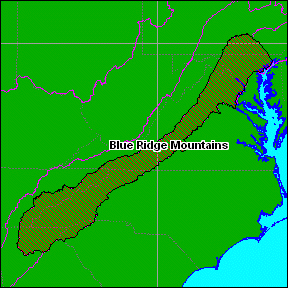Welcome to The Blue Ridge Gazette!

Welcome to The Blue Ridge Gazette!
"Welcome to the ancient, rumpled realm of the Blue Ridge Mountains."
The Blue Ridge is the extremely long mountain crest that runs from just north of the Potomac River on the Virginia-Maryland border south all the way to northern Georgia. The Blue Ridge Mountain Complex can be thought of as the Blue Ridge, with two main additions: its low continuations north of the Potomac into Maryland and Pennsylvania, and, more importantly, the whole series of high mountains centered on western North Carolina and extending west into Tennessee and south into Georgia. These high ranges include the Great Smokies and many others, and contain all of the 6000 foot peaks in the Appalachians except New Hampshire's Mt. Washington.
The entire huge complex of the Blue Ridge Mountains has clear natural boundaries. On the east, the mountains rise up distinctly from the flatter, rolling hills of the Piedmont. On the west, the Blue Ridge drops to the extraordinary Appalachian Valley, a continuous trough running from Alabama to Montreal.
The Blue Ridge and its associated ranges are almost entirely thickly forested, gentle, rounded mountains. Way too far south to even approach having a timberline, even the summits of Mt. Mitchell (6684') and Clingmans Dome (6636') are in the middle of deep forest and would have no views whatsoever if lookout towers hadn't been built. No other large mountain range in the country has as many good, paved roads meandering through the high country and up to important summits. And pointed, craggy summits as rare in the Blue Ridge as low, rounded ones are in the Tetons.
However, as with any huge area, generalizations are never totally true. There may not be any timberline, but the summits of many "Balds" in the Blue Ridge area are open meadows with often fine views. There are pockets of rugged, challenging terrain, and even a few peaks with rocky ledges at the summits that poke above the trees and provide spectacular mountain settings--Old Rag-3268 in Virginia and Grandfather Mountain-5984 in North Carolina come to mind.
The lack of challenging monster mountains isn't necessarily a drawback, either. The many high roads in this area, plus the gentle slopes and often short walks to summits from high trailheads, make the Blue Ridge an excellent place for mountain explorers who don't go for backpacking, rugged scrambling, or rock-climbing. A family or retired couple in their car doing easy dayhikes can spend huge amounts of time in the highest country in the east without ever getting a mile away from a car. Also, mountains need not present sheer, craggy faces to impress; the Blue Ridge charms with its endless waves of green hillsides, its incredibly diverse flora and fauna in its damp forests, its haunting blue morning mists (which gave the Blue Ridge and the Great Smokies their names), and the fascinating Appalachian culture of the long-time residents. Some of the mountain folk, isolated in their deep mountain hollows, speak English so similar to the Elizabethan dialect of the 1600s that it has interested Shakespearean scholars.
The very high average height of the southern Blue Ridge region gives it a climate that most people do not associate with the south. Winter snows can be heavy, and even spring blizzards can happen, as A.T. through-hikers getting an early start in April in Georgia sometimes find out. The area has the greatest rainfall in the contiguous U.S. outside of the Pacific Northwest, and is also much cooler and less humid than the surrounding lowlands. Asheville, NC, the large city in the center of the southern Blue Ridge Complex, has been rated as having one of the most pleasant climates, due to more bearable summers than in, say, Atlanta, with more bearable winters than found in places like New England. This pattern is less true for the northern Blue Ridge in Virginia, with its much lower elevations and much narrower mountain mass.
North of Roanoke, VA, the Blue Ridge is pretty much a single mountain crest. South of Roanoke, it startes expanding into a huge, wide, confusing oval of ranges and ridges that extends all the way into Georgia. To make sense of the entire complex, it has been divided into 4 sections: first,the Northern Blue Ridge, the single ridge north of Roanoke; second, the Southern Blue Ridge Front, which forms the eastern and southern edges of the large southern oval; third, the massive Great Smoky Mountains; fourth, the Western Blue Ridge Ranges, which are the other ranges at the western edge of the oval excepting the Smokies; and fifth and finally, the Central Blue Ridge Ranges, the jumble in the middle of the oval, which includes the Black Mountains and its high point, Mt. Mitchell (6684').












0 Comments:
Post a Comment
<< Home